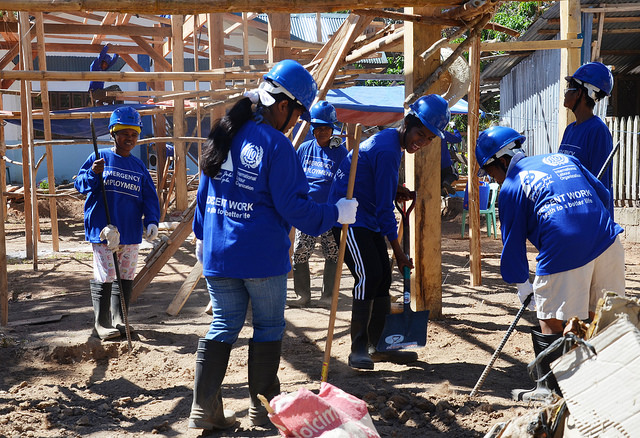The International Labour Organization (ILO) estimates 800,000 workers have been affected by Typhoon Hagupit, locally known as Ruby, with their source of livelihood damaged or disrupted overnight.
About 370,000 of these workers were in vulnerable employment, living in poverty and accepting whatever work is available to them.

Workers under the emergency employment programme in Coron, Palawan months after Typhoon Yolanda hit the Philippines in November 2013 (Photo by Karen Lapitan/ILO)
Initial ILO estimates covered eight regions in the country battered by the typhoon – Eastern, Central and Western Visayas, Caraga, Bicol, Calabarzon (Region 4A), Mimaropa (Region 4B) and Metro Manila.
Eastern Visayas accounted for the highest share of affected workers after Typhoon Ruby and most of them are still recovering from income lost to Super Typhoon Haiyan .
Over 350,000 workers or roughly 20 percent of the total employed in Eastern Visayas were affected by Typhoon Ruby. Of these, more than half were in vulnerable forms of employment.
With an average of 20 typhoons a year, the Philippines is the third most disaster-prone country in the world. In recent years, storms have been getting stronger and more deadly.
In response to the impact of Typhoon Hagupit, the ILO stands ready to allocate US$1.5 million and to support the government through emergency employment and sustainable livelihood.
Emergency employment programmes guarantee minimum wage, extend social security, health and accident insurance coverage, and ensure safety at work through the presence of on-site medical support and provision of personal protective equipment, such as mask, hat, gloves, boots and protective clothing.
“We’re not only putting much-needed cash into these areas, but also helping affected workers to develop new skills, to earn a decent wage and to access better working conditions including social protection coverage. These are not just labour rights but also basic human rights, which we need to take into account in times of crisis and disaster,” said Lawrence Jeff Johnson, Director of the ILO Country Office for the Philippines.
Working closely with the government, employers’ and workers’ organizations and the Humanitarian Country Team, the ILO will support partners and assist affected regions to ensure decent work and livelihood is at the forefront of recovery.
“Under the ILO emergency employment programme, affected workers get the chance to earn an income for their family and to receive much needed goods and services. This injection of cash into the local economy and the purchase of local goods and services create a multiplier effect to help build back better and faster after the disaster,” said Johnson.
The Department of Labor and Employment (DOLE) has further set aside funds for emergency employment. Labor and Employment Secretary Rosalinda Baldoz activated the DOLE Quick Response Team to immediately help displaced workers.
In 2013, the ILO emergency employment programme in areas affected by Super Typhoon Haiyan contributed to massive efforts for debris clearing and repair of critical community facilities and infrastructure. Emergency employment has now transitioned to medium-term labour-based community work, skills training and enterprise development in affected areas.
SOURCE: International Labor Organization
For more information about this topic, contact Minette Rimando from the Media and Public Information department of ILO Country Office for the Philippines through (632) 580-9900 or 05 or rimando@ilo.org.